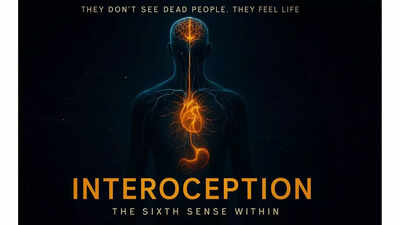Inside the Sixth Sense: The science of interoception |

Every human body hums with quiet communication. Beneath every heartbeat, hiccup, and hangover lies a secret chat line between your brain and your guts. It’s like WhatsApp, but the group chat is you. And unlike your actual group chats, this one never sleeps.
The science of the silent scream
Scientists have now decided to eavesdrop on this internal chatter, a “sixth sense” called interoception. Not the kind where Bruce Willis sees dead people, but the kind where your brain keeps tabs on your organs and politely reminds your heart not to take a lunch break.At the Scripps Research Institute and the Allen Institute, researchers are plotting the first-ever neural atlas of this hidden network, a Google Maps for the body’s internal signals. Funded by a $14.2 million NIH grant, it is being led by Nobel laureate Dr Ardem Patapoutian, who is essentially the man trying to teach your nervous system to stop ghosting your liver.“My team is honoured that the NIH is supporting the kind of collaborative science needed to study such a complex system,” said Dr Patapoutian, diplomatically avoiding the fact that mapping interoception sounds like trying to wiretap a cloud.
The sense you did not know you had
Unlike sight or sound, interoception does not rely on fancy equipment like eyes or ears. It is your body’s in-house news agency, constantly reporting breaking stories on blood pressure, gut grumbles, and immune whispers.It is the reason you know you are hungry, tired, or about to faint in a Zoom meeting. It is also why meditation apps keep telling you to “listen to your body”, as if your spleen is about to drop a mixtape.The problem is that scientists cannot easily record these inner messages. The neurons sending them are tucked deep inside organs, camouflaged like introverts at a rave. That is why Dr Patapoutian’s team is tagging them like wildlife, except instead of pandas, it is pain receptors and bladder signals.“We hope our results will help other scientists ask new questions about how internal organs and the nervous system stay in sync,” said Dr Li Ye of Scripps, proving that even researchers have to justify listening in on the body’s private conversations.
The body’s secret wiring
The project unfolds in two acts. First: track the nerve routes from the spinal cord to various organs using 3D imaging, think Apple’s Vision Pro but for your intestines. Second: decode the neuron types with genetic profiling, identifying which ones handle messages from your gut, bladder, or fat cells.Together, these steps will build the first comprehensive map of interoception, essentially the wiring diagram of how your body keeps calm while your brain panics.This atlas could redefine medicine, neuroscience, and maybe your next yoga retreat brochure.When the sixth sense breaks downWhen brain–body communication falters, things go haywire. Studies have linked faulty interoception to autoimmune disorders, chronic pain, high blood pressure, and even Alzheimer’s.In other words, your body’s internal signal bars drop and the call gets disconnected.“Interoception is fundamental to nearly every aspect of health, but it remains a largely unexplored frontier,” said Dr Xin Jin of Scripps. “By creating the first atlas, we hope to understand how the brain keeps the body in balance and what happens when someone hits airplane mode.”
Listening to your inner voice
This research is not just about neurons and organs. It is about decoding the quiet symphony that makes existence feel… well, alive. Every flutter, sigh, and calm breath is a message the brain translates without fanfare.And now, scientists are turning that silence into science, tuning in to the ultimate frequency: you.Because it turns out that the real “sixth sense” is not about seeing ghosts. It is about listening to your stomach before it starts haunting you.
Mapping the mind–body hotline
The NIH’s Transformative Research Award backs bold experiments that dare to redraw the boundaries of human understanding. The Scripps and Allen teams are doing just that, building the first neural Rosetta Stone for interoception.Their work could explain why emotions, stress, and physical sensations are so entangled, why heartbreak literally hurts, and why anxiety feels like bad Wi-Fi in your chest.And one day, this neural atlas might help restore balance when that hidden dialogue between the brain and the body, the one keeping you sane, breathing, and upright, goes silent.Until then, the next time your gut tells you something, listen carefully. Science just confirmed: it might actually be right.






